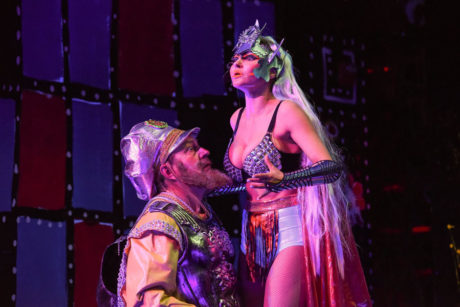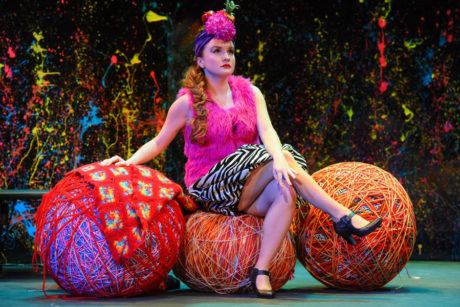Golden Cockerel (Coq d’Or) is a musical fantasy that was popular in the first half of the twentieth century but rarely seen since. Nikolai Rimsky-Korsakov composed it in 1907 with splashy orchestral colors — reminiscent of his Scheherazade — and that in itself would argue for its revival. The subject matter surprised me with its current relevance, adding depth and meaning to the work.

Rimsky-Korsakov and his librettist, Vladimir Belsky, had a political agenda, and they based the opera on a poem by Alexander Pushkin, an earlier Russian who also was politically motivated. Pushkin lived in a time with no freedom of speech, so he disguised liberal anti-czarist political messages in the form of fairy tales. In 1825 Pushkin’s poems were linked to the unsuccessful Decembrist Revolt against Czar Nicholas I. Some of Pushkin’s friends were executed or exiled to Siberia, and Pushkin himself was banished from Saint Petersburg to the Caucasus mountains. After that, he wrote Golden Cockerel and he died in a duel at the age of 37. (Pushkin was inspired by Washington Irving’s 1832 story The Alhambra, about a Moorish king who built towers on his borders to prevent foreign entry, and who made a bargain with an astrologer and failed to honor it, whereupon the astrologer seized what he desired and disappeared into a subterranean world.)
Rimsky-Korsakov had been an officer in the Imperial Russian Navy, and was famed for his Russian nationalism, expressed musically with exotic harmonies and melodies. He wrote Scheherazade and Russian Easter Overture, the miniature Flight of the Bumblebee, and he completed Mussorgsky’s Boris Gudunov and Borodin’s Prince Igor.
In January 1905, thousands demonstrated in Saint Petersburg for voting rights and better working conditions, and many of them were shot dead by czarist troops, while sailors mutinied against their officers at the port of Odessa. (This became the basis of Sergei Eisenstein’s 1925 film Battleship Potemkin.) Rimsky-Korsakov supported these protests and was soon dismissed from his position as head of the Saint Petersburg Conservatory.
The czar told his supporters that he would “bring order back to Russia” but granted only limited reforms, and revolutionary activity increased. Labor unions (Soviets) became the main agitators. The empire was to fall in 1917.
Golden Cockerel had its premiere in 1909, after Rimsky’s death. It is a satire of the autocracy, of Russian imperialism, and of the Russo-Japanese war which was started by Czar Nicholas II and ended in disaster. This production was designed and directed by Igor Konyukhov, founder of New Opera NYC, a Russian born PhD in nuclear physics who became a director and choreographer.
The costumes combine 1960s psychedelia with the primitive oriental look which Rimsky and librettist Belsky associated with czarist Russia. Day-Glo luminescent colors predominated. Rimsky would have enjoyed seeing the hippie attire of this production; he himself chose to wear blue-tinted, wire-rimmed glasses, even when he was in his 60s.
The solo trumpet fanfare that opens the opera is thrilling; it’s one of the most distinctive of all brass solos. This leads into an orchestral score filled with exoticism. J. David Jackson, who has conducted Russian opera in major houses, including Prokofiev’s War and Peace at the Met, vividly led a 36-piece orchestra.
King (or Czar) Dodon thinks that evil enemies “from the East” are threatening his kingdom, so he orders a preemptive war. His attack ends in disaster and his two sons, who led his army, stab each other to death. Dodon then takes personal command, but he chooses to pull back his troops and defend the homeland. Ksenia Antonova as the Golden Cockerel perched in a tree and scanned the horizon with binoculars, looking for invading armies.

In Act II, Dodon is confronted by Shemakha, queen of the enemy nation. Appearing in black light with blue skin, set off by bright orange lips and eye liner, she sings a languorous Hymn to the Sun. Alexandra Batsios was sensuous, wearing a colorful gown and veils. She led Dodon into his own dance, which was a comic travesty. Shemakha told Dodon that he looked like a camel, or a hopping turkey, but eventually the two of them connected romantically.
At the wedding ceremony, the Astrologer asks Dodon to make good on his “campaign promise” to grant any wish of the Astrologer. “I want the Queen of Shemakha” says the Astrologer. Dodon furiously kills him with a blow from his mace. The Golden Cockerel, defending its master, swoops down and severs Dodon’s jugular vein.
The cast sing about the dawn of a “new day” — happy to see the czar overthrown. But then they ask plaintively, “How will we live without the czar?” Pushkin apparently was prescient about what was to happen in the Soviet Union.
Or perhaps not. This uncertainty about Russia’s future had been expressed in earlier Russian operas, most notably in Boris Gudonov. Maybe Pushkin (or librettist Belsky) had intuition about the Bolshevik and Communist reigns, and the Stalinist dictatorship, that were to come. The possibility prompts serious thought at the end of this otherwise-comical opera. It adds dimension during today’s worldwide regime changes.
At the end of the opera the Astrologer tells us that what we’ve seen is fiction, and only he and the queen were real. Belsky asked, “Did they hatch a plot against Dodon? Did they meet by accident, both intent on the czar’s downfall? Pushkin does not tell us.”
At the Met in the 1930s and 1940s, the lead roles of King Dodon and Queen Shemakha were usually sung by Ezio Pinza and Lily Pons. At New York City Opera in the 1960s they were a specialty of Norman Treigle and Beverly Sills. Mikhail Svetlov, from the Bolshoi, made a tour de force of his role. He has a commanding bass voice and great stage presence. In the performance I attended, Batsios was more dramatic than the chirpy Zerbinetta-like voices of the past. She had a rich sound and also commanded the high E (above high C) that caps her aria. Julia Lima alternated with Batsios as the queen.
The part of the Astrologer is written for a voice called “tenor altino.” It is a very high lyric which shifts into falsetto. John Villamaire made the part strangely appealing. Ksenia Berestovskaya displayed a major mezzo voice as Amelfa, the cook, with fruit and flowers atop her head. This is a role once sung at the Met by Margaret Harshaw. The title role is a featured spot, not really a lead role, and Ksenia Antonova competently handled its high coloratura.
These performances were in Russian, with English titles. The Met used to do it in French, and New York City Opera sang it in English.
Running Time: Two hours and 40 minutes, with one intermission.

Golden Cockerel was presented May 18-21, 2017, by New Opera NYC, performing at the Loreto Theater at the Sheen Center for Thought & Culture – 18 Bleecker Street, in New York, NY. Tickets to future shows may be purchased online.




